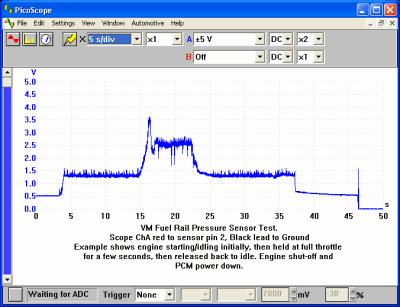 |
This is a good waveform |

 View larger image View larger image
 Download this waveform file for use with PicoScope Download this waveform file for use with PicoScope
Fuel Pressure Sensor – Common Rail Diesel Waveform Notes
This waveform shows a test of the fuel system on a common rail diesel engine, using the fuel rail pressure sensor.
The PCM varies the rail pressure between about 280 bar at idle and 1600 bar at full speed and load. The sensor is the feedback component in a control loop, and informs the PCM what pressure is in the rail. The PCM can then tell the pump to increase or decrease output accordingly. The PCM controls the pressure regulator or “M-Prop” valve on the pump to control pump pressure. When you press the pedal, the PCM will immediately calculate how much fuel to give the engine based on speed, load, etc. and the internal calibration table. This fuelling table is specifically for that engine/vehicle combination. The sensor gives a continual feedback of rail pressure so that the PCM can make any pressure adjustments almost instantaneously.
We can analyse the performance of the system by graphing the output of the sensor against time, whilst we start, run, accelerate, hold at full speed, and return to idle. We finally switch off and wait for PCM power down (normally around 10 seconds after key-off). The scope is best set to a slow time base in chart recorder mode.
The waveform starts on the left just after key-on, where the voltage is 0.5 V, corresponding to a pressure of 0 bar. The sensor does this to provide a plausibility check: it should never normally read 0 V, so if it does, it has failed. When we start the engine, the voltage rises to about 1.3 V, which corresponds to about 280 bar, a common value at idle. We then put the pedal to the floor, and the PCM immediately adds a shot of fuel to accelerate the engine to red-line, where it is held by the speed governor. The voltage then settles back to a lower value, about 2.5 V, until we release the pedal back to idle, when it settles back to 1.3 V as at the start. We then key-off and the engine stops. Note how the signal drops slowly back to 0.5 V over about 10 seconds, before the PCM powers down near the right-hand end of the waveform. If the voltage drops very quickly to 0.5 V, then the residual pressure is leaking away too quickly, and may indicate a problem with the system — for example, a leaky injector, or a leak back through the pump. Remember that this test is done on an unloaded engine. On a fully loaded engine the centre section of the graph will rise well above 2.5 V. It won’t go above 4.5 V, as this represents about 1600 bar. Again, this is a plausibility check on the sensor: if it goes to 5 V (the sensor supply voltage), there could be a fault with the sensor.
汽车诊断 | 汽车诊断仪 | 汽车故障诊断仪 | 汽车测试仪 | 汽车分析仪 | 汽车诊断示波器 | 汽车电路测试仪 | 汽车电路分析仪 | 发动机分析仪 | 发动机综合分析仪 | 发动机检测中心 | 点火分析仪 | 点火测试仪 | 汽车传感器测试仪 | CAN总线示波器 | LIN总线示波器 | 汽车故障记录仪 | 汽车传感器分析仪 | 汽车检测仪 | 喷油嘴测试仪 | 点火线圈测试仪 | 蓄电池测试仪 | 发电机测试仪 | 起动机测试仪 | ABS传感器测试仪 | ECU测试仪 | ECM测试仪 | 进气真空/压力测试仪 | 排气压力测试仪 | 汽车技术培训 | 爆震传感器测试仪 | 缺火测试仪 | 缺缸测试仪 | 线路测试仪 | 引出线 | 汽车数字示波器 | 真空传感器 | 高压感应测试头 | 无分电器点火测试头 | 独立点火(COP)感应测试头 | 漏电测试仪 | 气缸相对压缩测试 | 电脑测试仪 | 发动机控制器测试仪 | 泄漏测试仪 | 荧光检漏 | 超声波检漏 | 汽车数字万用表 | 电流钳表 | 电流勾表 | 点火正时灯 |



